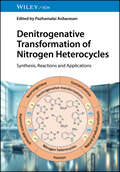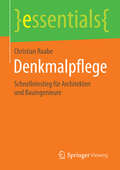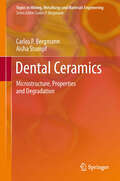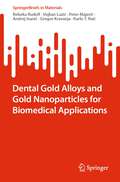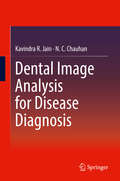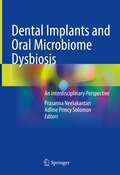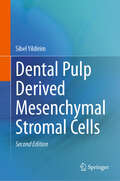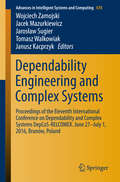- Table View
- List View
Denitrogenative Transformation of Nitrogen Heterocycles: Synthesis, Reactions and Applications
by Pazhamalai AnbarasanComprehensive resource exploring a unique chemical transformation that generates new compounds with diverse properties for modern organic synthesis research Denitrogenative Transformation of Nitrogen Heterocycles explores all 10 polynitrogen heterocycles that are known to undergo denitrogenative transformations to date. Following highlights on the remarkable modifications encountered in the synthesis of nitrogen heterocycles, the chapters use a reaction-based approach to explain denitrogenative transformations in detail. This book covers the exponential growth in scientific literature in the last few decades for denitrogenative reactions of polynitrogen heterocycles which play a key role in natural products, medicinal chemistry, pharmaceuticals, biochemistry, and material sciences. This book also discusses denitrogenative cascade reactions, which accomplish powerful transformations from simple polynitrogen heterocycles to more complex molecules in modern synthetic chemistry. Written by a highly qualified academic with significant experience in the field, Denitrogenative Transformation of Nitrogen Heterocycles covers sample topics including: Transannulation of N-sulfonyl-1,2,3-triazoles with polar multiple bonds such as carbonyls and nitriles and non-polar multiple bonds such as alkenes, alkynes, and allenesInsertion of azavinyl carbenes to C–X/X–X bond, denitrogenative rearrangements of N-sulfonyl-1,2,3-triazoles, and denitrogenative transformations of NH- and N-fluoroalkyl-1,2,3-triazolesMetal-catalyzed and metal-free denitrogenative transformations of pyridotriazoles and denitrogenative transannulation of benzotriazoles and thiadiazolesDenitrogenative transformations of tetrazoles and radical denitrogenative transformations of polynitrogen heterocycles The first book of its kind on the subject, Denitrogenative Transformation of Nitrogen Heterocycles is an essential reference for researchers and scientists working in organic chemistry, organometallic chemistry, and transition metal catalysis, as well as academics and industry professionals in related fields.
Denizens of the Deep: True Tales of Deep Sea Fishing
by Philip WylieA Collection of Stories about Fish, Fishermen, and Favorite Fishing Spots with Action on Every Page The incomparable Philip Wylie is here writing about one of the things he likes best--fishing. Anyone who has ever wet a line, and perhaps those few benighted souls who haven’t, will be thrilled to read these true tales about the big ones, hooked (and sometimes lost) in tropic waters. In Denizens of the Deep, which was originally published in 1947, there are wonderful chapters on marlin, the "admirable” barracuda, and the shark, whom Wylie calls "that misunderstood fish. ” The bursting pride when you catch that first big one is recaptured with fine nostalgia in the essay "What Makes a Great Day’s Fishing?” and the tragedy of the clean getaway in "Listen to This Tale of Woe. ” Serious fishermen with an interest in the pastime’s history will also find much valuable information in the chapter on the International Game Fish Association.
Denkmalpflege: Schnelleinstieg für Architekten und Bauingenieure (essentials)
by Christian RaabeDieses essential behandelt die vier wichtigsten Themenfelder der Denkmalpflege, die in ihren Grundzügen dargestellt werden: Geschichte, Organisation, Praxis und Forschung. Christian Raabe zeigt in einem kurzen Abriss der Geschichte, wie sich Wertebegriffe und die Institutionalisierung der Denkmalpflege historisch entwickelt haben. Es folgen eine Darstellung der Aufgaben und Strukturen der nationalen und internationalen Organisation des Denkmalschutzes, Hinweise zum rechtlichen Umfeld und Handlungsempfehlungen zur praktischen Denkmalpflege nebst einer Übersicht der Fördermöglichkeiten. Diese praxisnahe Einführung schließt der Autor mit einer Erläuterung der Ziele und Methoden der historischen Bauforschung ab.
Denkmalschutz-Kompendium: Handreichung für die behördliche Praxis
by Moritz WildDenkmalschutzbehörden vollziehen die Denkmalschutzgesetze und wenden hierzu denkmalpflegerische Kenntnisse in Verwaltungsvorgängen an. Das Denkmalschutz-Kompendium verbindet daher Denkmalpflegetheorie mit Denkmalrecht und Verwaltungspraxis. Es bietet Sachbearbeitern in der Denkmalschutzbehörde und benachbarten Fachbereichen eine anwendungsbezogene und alltagsgerechte Hilfestellung zur Einarbeitung. Es zeigt auf, welche Aufgaben und welche Rahmenbedingungen angesichts der Klimarettung und des ökologischen Stadtumbaus auf die Sachbearbeiter zukommen und welche Methoden diese zur Bewältigung der Aufgaben anwenden können. Neue Sachbearbeiter sollen dadurch schneller die nötigen Grundkenntnisse erlangen, um lösungsorientiert mit den Beteiligten zusammenzuarbeiten.
Denkmalschutz: Grundwissen für Denkmaleigentümer (essentials)
by Moritz WildDieses essential vermittelt Denkmaleigentümern und ihren Auftragnehmern Grundlagen zur Erhaltung und Modernisierung von Denkmälern, zur Kommunikation mit Behörden und zur Antragstellung. Es beleuchtet die Themen Unterschutzstellung, Zumutbarkeit, Energieeffizienz und Klimaschutz. Und es gibt Hinweise zur Integration erneuerbarer Energien in den historischen Baubestand.
Dennis Tito, the First Space Tourist
by Heather FeldmanDennis Tito dreamed of taking a vacation in outer space his whole life, and when he was 60 his dream finally came true. This book tells the story of one man's determination to achieve his dreams, and the obstacles he encountered before finally seeing it come to life. The book also examines the growing interest in space tourism including information on a possible space mission by N'SYNC's Lance Bass.
Dense Phase Carbon Dioxide: Food and Pharmaceutical Applications
by Murat O. Balaban Giovanna FerrentinoDense phase carbon dioxide (DPCD) is a non-thermal method for food and pharmaceutical processing that can ensure safe products with minimal nutrient loss and better preserved quality attributes. Its application is quite different than, for example, supercritical extraction with CO 2 where the typical solubility of materials in CO 2 is in the order of 1% and therefore requires large volumes of CO 2. In contrast, processing with DPCD requires much less CO 2 (between 5 to 8% CO 2 by weight) and the pressures used are at least one order of magnitude less than those typically used in ultra high pressure (UHP) processing. There is no noticeable temperature increase due to pressurization, and typical process temperatures are around 40°C. DPCD temporarily reduces the pH of liquid foods and because oxygen is removed from the environment, and because the temperature is not high during the short process time (typically about five minutes in continuous systems), nutrients, antioxidant activity, and vitamins are much better preserved than with thermal treatments. In pharmaceutical applications, DPCD facilitates the production of micronized powders of controlled particle size and distribution. Although the capital and operating costs are higher than that of thermal treatments, they are much lower than other non-thermal technology operations. This book is the first to bring together the significant amount of research into DPCD and highlight its effectiveness against microorganisms and enzymes as well as its potential in particle engineering. It is directed at food and pharmaceutical industry scientists and technologists working with DPCD and other traditional or non-thermal technologies that can potentially be used in conjunction with DPCD. It will also be of interest to packaging specialists and regulatory agencies.
Dense and Green Building Typologies: Design Perspectives (SpringerBriefs in Architectural Design and Technology)
by Thomas Schröpfer Sacha MenzIn this book, leading architects and landscape architects provide their perspectives on the design of dense and green building types in high-density urban contexts that can support higher population densities, higher standards of environmental sustainability and enhanced liveability in future cities.
Dense and Green Building Typologies: Research, Policy and Practice Perspectives (SpringerBriefs in Architectural Design and Technology)
by Thomas Schröpfer Sacha MenzIn this book, academics, policy makers, developers, architects and landscape architects provide a systematic review of the environmental, social, economic and design benefits of dense and green building types in high-density urban contexts and discuss how these can support higher population densities, higher standards of environmental sustainability and enhanced live ability in future cities.
Density Evolution Under Delayed Dynamics: An Open Problem (Fields Institute Monographs #38)
by Richard Taylor Michael C. Mackey Marta Tyran-Kamińska Jérôme LossonThis monograph has arisen out of a number of attempts spanning almost five decades to understand how one might examine the evolution of densities in systems whose dynamics are described by differential delay equations. Though the authors have no definitive solution to the problem, they offer this contribution in an attempt to define the problem as they see it, and to sketch out several obvious attempts that have been suggested to solve the problem and which seem to have failed. They hope that by being available to the general mathematical community, they will inspire others to consider–and hopefully solve–the problem. Serious attempts have been made by all of the authors over the years and they have made reference to these where appropriate.
Dental Applications of Nanotechnology
by Ramesh S. ChaughuleThis book discusses current trends and potential areas of nanotechnology applications in dental materials. Dentistry is undergoing yet another change to benefit mankind via the discipline of nanodentistry. A variety of nanostructures such as nanorobots, nanospheres, nanofibers, nanorods, etc., have been studied for various applications in dentistry and medicine. Preventive dentistry has also utilized nanodentistry to develop the nanomaterials for inclusion in a variety of oral health-care products. Methods to prevent and combat dental problems have been devised, discussed, and implemented since ancient times; however, there is a constant need for improved tools and techniques. This book is relevant academically for undergraduate and post-graduate dental students, dental practitioners, researchers, and faculties of dental universities, as this book explores the application of various nanobiomaterials in dentistry, discusses current research in dental nanomaterials and potential future areas of interest, and examines the use of nanotechnology in various fields of dentistry.
Dental Biomechanics
by Arturo N NataliDental Biomechanics provides a comprehensive, timely, and wide-reaching survey of the relevant aspects of biomechanical investigation within the dental field. Leading the reader through the mechanical analysis of dental problems in dental implants, orthodontics, and natural tooth mechanics, this book covers an increasingly important and popular sub
Dental Biotribology
by Jing Zheng Hai-Yang Yu Lin-Mao Qian Yu Yan Zhong-Rong ZhouDental Biotribology summarizes the latest achievements in dental wear and is designed to help the reader better understand the relationship between structures and tribological properties of human teeth. This book provides guidance on the biomimic design of anti-wear engineering systems based on human teeth and also explains mechanisms of occlusal wear and erosion as well as fretting wear related to dental implants and orthodontics. Additionally, this book provides valuable insights into the development of improved dental materials and oral treatments.
Dental Ceramics: Fracture Mechanics and Engineering Design
by Ulrich Lohbauer Renan BelliThis book is an evidence-based update on recent most significant advances in dental ceramics, specifically related to the relationships between composition, microstructure and mechanical behavior. Readers will find an introduction to the chemistry of dental ceramics as well as information about the technological progress and practical requirements restorative materials need to satisfy for long-lasting structural integrity. The book uses mechanistic approaches to address failure mechanisms from controlled experiments thus providing the tools for the application of sound research methodologies in the field. It is targeted for researcher and dentists interested in the field of dental ceramic materials and fracture mechanics.
Dental Ceramics: Microstructure, Properties and Degradation
by Aisha Stumpf Carlos BergmannThis book gives an introduction to the mechanical behavior and degradation of dental ceramics and guides the reader through their performance under effect of oral environments. It addresses the different kinds of dental ceramics, their properties, degradation and mechanical aspects with less emphasys on the physics and chemistry involved, which makes the reading interesting for beginners in the field. In each chapter, the reader will learn about the mechanical behavior of dental ceramics and each phenomenon involved in their application, besides finding some practical examples of their use in dental clinics, their manufacturing procedures and types of degradation. The clear language and the application-oriented perspective of the book makes it suitable for both professionals and students who want to learn about dental ceramics.
Dental Gold Alloys and Gold Nanoparticles for Biomedical Applications (SpringerBriefs in Materials)
by Rebeka Rudolf Vojkan Lazić Peter Majerič Andrej Ivanič Gregor Kravanja Karlo T. RaićThis book focuses on recent advances in dental gold alloys and gold nanoparticles (GNPs) for biomedical applications. Dental gold alloys combine several highly desirable mechanical properties, such as high strength, ductility, and elasticity, with an extremely robust chemical stability in the mouth. Moreover, astonishing progress has been made in the use of GNPs as novel gold biomaterials that provide a multifunctional platform for cellular imaging, biosensing, and targeted drug delivery in tumour immunotherapy and photothermal therapy. Beginning with a comprehensive overview of the development and use of dental gold alloys, the book addresses the materials properties that are crucial for dental applications, focusing on aspects such as microstructure, chemical and mechanical stability, ageing, biocompatibility, and colour retention. The book then shifts focus to the use of GNPs in dental applications, delving into different techniques of GNP synthesis for specifically tailoring the size, shape, and stability of GNPs in biological media. In addition to these factors, it addresses how their exposure route, surface chemistry, as well as how the steric effects of their coating impact biodistribution and determine the level of GNP toxicity in the human body. Featuring topical literature reviews alongside up-to-date published experimental results, this book offers an attractive resource for practicing scientists and engineers working in the field of gold-based biomaterials.
Dental Image Analysis for Disease Diagnosis
by Kavindra R. Jain N. C. ChauhanThis book provides an overview of computational approaches to medical image examination and analysis in oral radiology, utilizing dental radiograph to detect and diagnose dental caries in cases of decayed teeth. Coverage includes basic image processing techniques; approaches for Region of Interest extraction and analysis; and the role of computational clustering techniques for segmentation of teeth and dental caries. The book also presents a novel multiphase level set method for automatic segmentation of dental radiographs.
Dental Image Processing for Human Identification
by Rohit M. Thanki Ashish M. Kothari Deven N. Trivedi Nimit D. ShahThis book presents an approach to postmortem human identification using dental image processing based on dental features and characteristics, and provides information on various identification systems based on dental features using image processing operations. The book also provides information on a novel human identification approach that uses Infinite Symmetric Exponential Filter (ISEF) based edge detection and contouring algorithms.
Dental Implants and Oral Microbiome Dysbiosis: An Interdisciplinary Perspective
by Prasanna Neelakantan Adline Princy SolomonThis book will serve as a one-stop, reference manual to understand the basic concepts of dental implant design, the related microbiome, research models and current concepts as well as futuristic perspectives in implant surface modification. The manual-like design including colorful illustrations and important critical questions will help researchers and advanced students in understanding the contemporary status and in designing studies for innovative treatments of dental implant infections. Considering the microbiome of dental implant related environment in health and disease is imperative to design strategies to good practice and prevention of infections around implants. This monograph will serve as a single reference material which links the interdisciplinary aspect of the dental implants covering material sciences, engineering and biological aspects, thus effectively bridging the gap between engineering and oral health sciences.
Dental Pulp Derived Mesenchymal Stromal Cells
by Sibel YildirimThis book presents an evaluation of stem cells from human dental pulp as a reliable stem cell source for cell-based therapy to stimulate tissue regeneration. In this thoroughly updated and expanded second edition, the author covers mesenchymal stem cell (MSC) biology, various sources of MSCs, and the therapeutic potential of MSCs. Tooth regeneration, dental pulp-derived MSC, and the therapeutic potential of dental pulp derived stem cells is also covered. This is an essential resource for students, faculty, and researchers in academia and industry working on dental pulp stem cells.
Dental Pulp Stem Cells
by Sibel YildirimStem cell technology is moving forward at a tremendous rate. Recent discoveries have surprised even the most expert researchers. While every piece of new data broadens the current knowledge and contributes to this moving forward, the new data also serve as paradigm shifters of fundamental knowledge of cell biology. While the question 'What is a Stem Cell' may now seem to basic to even discuss, there are still some discrepancies, however, between groups in terms of their functional roles. Teeth develop from the ectoderm of the first branchial arch and the ectomesenchyme of the neural crest. Deciduous teeth start to form between the sixth and eighth weeks, and permanent teeth begin to form in the twentieth weeks. Several studies have demonstrated that the pulp from both adult teeth and deciduous teeth contains dental pulp stem cells. Several factors have made them very attractive as a model system for many researchers; they are multipotent, ethically and non-controversially available in large numbers, immuno-compatible, developmentally primitive, easy to isolate and have high expansion potential in vitro. However, many controversies still exist in the field. There are several unanswered questions in the biology of dental pulp and odontoblasts. This new volume in the SpringerBriefs in Stem Cells series presents an evaluation of stem cells from human dental pulp as a reliable stem cell source for cell-based therapy to stimulate tissue regeneration.
Departure
by A. G. RiddleThe world's past and future rests in the hands of five unwitting strangers in this time-traveling, mind-bending speculative thriller from the author of the bestselling Origin Mystery trilogyEn route to London from New York, Flight 305 suddenly loses power and crash-lands in the English countryside, plunging a group of strangers into a mysterious adventure that will have repercussions for all of humankind.Struggling to stay alive, the survivors soon realize that the world they've crashed in is very different from the one they left. But where are they? Why are they here? And how will they get back home? Five passengers seem to hold clues about what's really going on: writer Harper Lane, venture capitalist Nick Stone, German genetic researcher Sabrina Schröder, computer scientist Yul Tan, and Grayson Shaw, the son of a billionaire philanthropist.As more facts about the crash emerge, it becomes clear that some in this group know more than they're letting on--answers that will lead Harper and Nick to uncover a far-reaching conspiracy involving their own lives. As they begin to piece together the truth, they discover they have the power to change the future and the past--to save our world . . . or end it. A wildly inventive and propulsive adventure full of hairpin twists, Departure is a thrilling tale that weaves together power, ambition, fate, memory, and love, from a bold and visionary talent.
Dependability Engineering and Complex Systems
by Janusz Kacprzyk Wojciech Zamojski Jacek Mazurkiewicz Jarosław Sugier Tomasz WalkowiakThese proceedings present the results of the Eleventh International Conference on Dependability and Complex Systems DepCoS-RELCOMEX which took place in a picturesque Brunów Palace in Poland from 27th June to 1st July, 2016. DepCoS-RELCOMEX is a series of international conferences organized annually by Department of Computer Engineering of WrocÅ,aw University of Science and Technology since 2006. The roots of the series go as far back as to the seventies of the previous century - the first RELCOMEX conference took place in 1977 - and now its main aim is to promote a multi-disciplinary approach to dependability problems in theory and engineering practice of complex systems. Complex systems, nowadays most often computer-based and distributed, are built upon a variety of technical, information, software and human resources. The challenges in their design, analysis and maintenance not only originate from the involved technical and organizational structures but also from the complexity of the information processes that must be efficiently executed in a diverse, often hostile operational environment. Traditional methods of reliability evaluation focused only on technical resources are usually insufficient in this context and more innovative, multidisciplinary methods of dependability analysis must be applied. The diversity of the topics which need to be considered is well illustrated by the selection of the submissions in these proceedings with their subjects ranging from mathematical models and design methodologies through software engineering and data security issues up to practical problems in technical, e. g. transportation, systems.
Dependability in Electronic Systems
by Yutaka Uematsu Nobuyasu Kanekawa Eishi H. Ibe Takashi SugaThis book covers the practical application of dependable electronic systems in real industry, such as space, train control and automotive control systems, and network servers/routers. The impact from intermittent errors caused by environmental radiation (neutrons and alpha particles) and EMI (Electro-Magnetic Interference) are introduced together with their most advanced countermeasures. Power Integration is included as one of the most important bases of dependability in electronic systems. Fundamental technical background is provided, along with practical design examples. Readers will obtain an overall picture of dependability from failure causes to countermeasures for their relevant systems or products, and therefore, will be able to select the best choice for maximum dependability.
Dependability in Medicine and Neurology
by Nikhil BalakrishnanThis ground-breaking title presents an interdisciplinary introduction to the subject of Dependability and how it applies in medicine generally and in neurology in particular. Dependability is the term applied in engineering and industry to a service that is safe, reliable and trustworthy. Dependable systems use a variety of methods to deliver correct service in the face of uncertainty resulting from misleading, erroneous information, and system faults. Dependable systems result from the application of systematic methods in design, operation, and management to deliver their services. Dependability in Medicine and Neurology presents the philosophy and ideas behind the specific methods of dependability and discusses the principles in the context of medical care and neurologic treatment especially. Patient case vignettes are used widely to illustrate key points. A first-of-its-kind title and based on the author's many years of teaching these principles to medical colleagues throughout the United States, Dependability in Medicine and Neurology will inspire readers to develop applications for their specific areas of clinical practice. Intended for physicians (especially neurologists), medical students, nurses, and health administrators, Dependability in Medicine and Neurology is an indispensable reference and important contribution to the literature.
